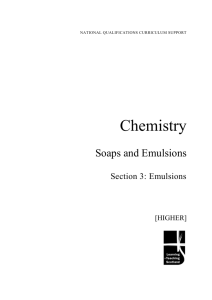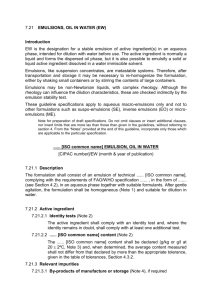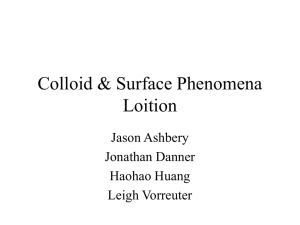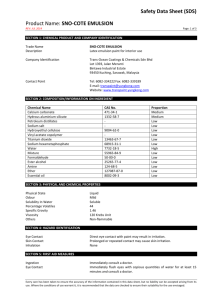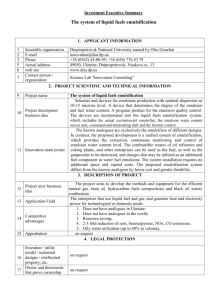Emulsions and Suspensions. Paragraphs 4-1 through 4-14.
advertisement
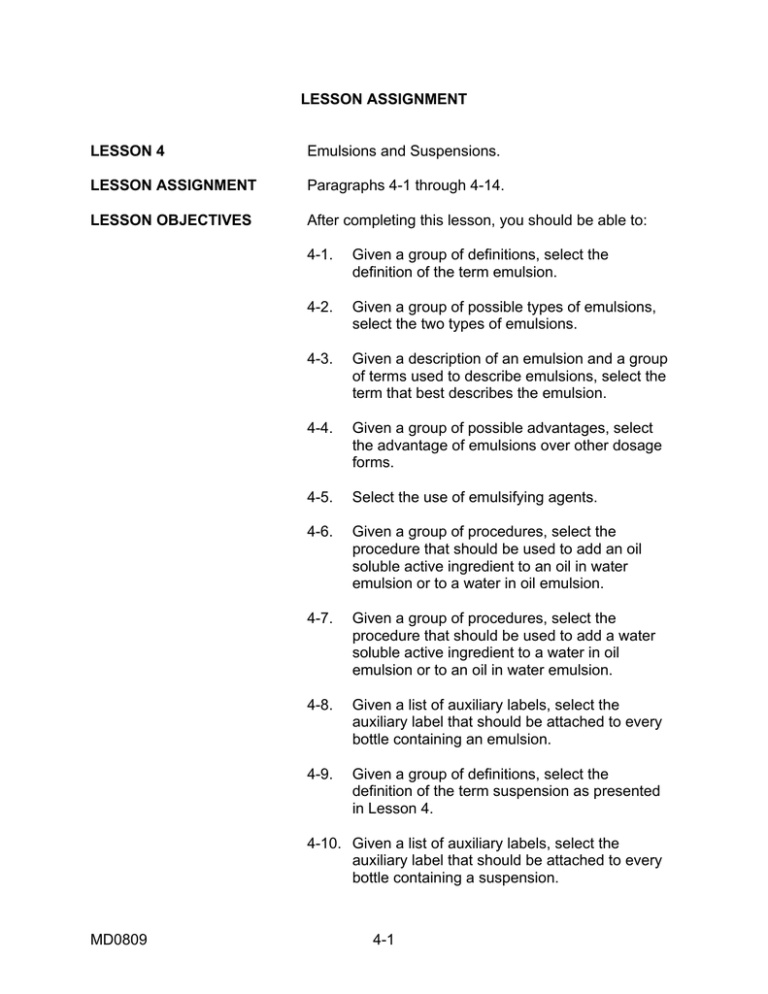
LESSON ASSIGNMENT LESSON 4 Emulsions and Suspensions. LESSON ASSIGNMENT Paragraphs 4-1 through 4-14. LESSON OBJECTIVES After completing this lesson, you should be able to: 4-1. Given a group of definitions, select the definition of the term emulsion. 4-2. Given a group of possible types of emulsions, select the two types of emulsions. 4-3. Given a description of an emulsion and a group of terms used to describe emulsions, select the term that best describes the emulsion. 4-4. Given a group of possible advantages, select the advantage of emulsions over other dosage forms. 4-5. Select the use of emulsifying agents. 4-6. Given a group of procedures, select the procedure that should be used to add an oil soluble active ingredient to an oil in water emulsion or to a water in oil emulsion. 4-7. Given a group of procedures, select the procedure that should be used to add a water soluble active ingredient to a water in oil emulsion or to an oil in water emulsion. 4-8. Given a list of auxiliary labels, select the auxiliary label that should be attached to every bottle containing an emulsion. 4-9. Given a group of definitions, select the definition of the term suspension as presented in Lesson 4. 4-10. Given a list of auxiliary labels, select the auxiliary label that should be attached to every bottle containing a suspension. MD0809 4-1 4-11. Given a group of statements, select the statement that best applies to the storage of suspensions. 4-12. Given several groups of auxiliary labels, select the group that contains the auxiliary labels required on bottles containing lotions dispensed to patients. SUGGESTION MD0809 After completing the assignment, complete the exercises at the end of this lesson. These exercises will help you to achieve the lesson objectives. 4-2 LESSON 4 EMULSIONS AND SUSPENSIONS Section I. EMULSIONS 4-1. INTRODUCTION At one time emulsions were frequently prepared in the pharmacy. Now, the emulsions used in medical practice are primarily prepared by pharmaceutical manufacturers. This area of the subcourse will discuss some important considerations of emulsions. Should you be required to prepare an emulsion, you should consult a reference such as Remington's Pharmaceutical Sciences. 4-2. BACKGROUND INFORMATION a. Definition. An emulsion is a liquid composed of two immiscible liquids (two substances which will not mix together), such as oil and water, in which one liquid is dispersed in small globules throughout the other liquid. The world's most naturally occurring emulsion is milk. b. Parts of an Emulsion. An emulsion usually consists of two distinct liquids called phases. One phase consists of tiny globules. The other phase is the liquid surrounding the globules. The globule phase may be called the inner phase, the internal phase or the dispersed phase. The surrounding liquid is called the external phase or the continuous phase. See figure 4-1, which illustrates the two phases of an emulsion. Figure 4-1. Microscopic view of the two phases of an emulsion. MD0809 4-3 c. Types of Emulsions. An emulsion usually consists of oil and water. When the oil is the internal phase and the water is the external phase, the emulsion is said to be an oil-in-water (o/w) emulsion. When the water is the internal phase and the oil is the external phase, it is a water-in-oil (w/o) emulsion. d. Creaming. Unhomogenized milk will separate into two layers while standing. However, if it is shaken, the two layers will disappear. When an emulsion separates in this manner, we say that it has creamed. The emulsion is still good since there is no separated oil visible. e. Cracking. When an emulsion separates into layers of oil and water and shaking cannot restore the original emulsion, we say that the emulsion has cracked. That is, it is no longer pharmaceutically useful as an emulsion. 4-3. THE USE OF EMULSIONS Emulsions are used because they have some distinct advantages over other types of dosage forms. Internally, the emulsion is a satisfactory form of dosage for large quantities of unpleasant oily liquids, which cannot be given in capsules. These doses are rapidly and completely-assimilated. Thus, an oil-in-water (o/w) emulsion of cod liver oil can be prepared in which the flavored aqueous liquid surrounding the oil globules masks the greasiness and the bad taste of the oil. Externally, an emulsion can provide a homogenous ointment or lotion, which contains both oil and water soluble ingredients. Emulsions provide palatable internal preparations and uniform dosages of both internal and external preparations. 4-4. EMULSIFYING AGENTS a. Overview. As you know, oil and water do not mix. Since oil and water do not mix, how is it possible to form the two phases required for an emulsion? The answer is simple--emulsifying agents. b. Definition. An emulsifying agent, or emulsifier, is any substance that will promote the formation of an emulsion. The chemical structure of an emulsifying agent promotes the formation of an emulsion. c. Examples of Emulsifying Agents. Acacia and tragacanth are used as emulsifying agents. For specific information on the amount of an emulsifying agent that must be used to prepare an emulsion, you should consult a reference such as Remington's Pharmaceutical Sciences. 4-5. METHODS USED TO PREPARE EMULSIONS Emulsions are infrequently prepared in the pharmacy. Thus, this subcourse will not provide detailed instructions for the preparation of emulsions. You should be aware that several methods exist for the preparation of this dosage form. The two methods most frequently used are the continental method and the bottle method. MD0809 4-4 a. Continental Method (4-2-1 Method). This is the most commonly used method for the preparation of emulsions. The common name, the 4-2-1 Method, describes the ratio of fixed oil, water, and acacia used to prepare the basic emulsion. For specific information on this method, see Remington's Pharmaceutical Sciences. b. Bottle Method. This method is used to prepare small quantities of volatile oil emulsions. In this method, two parts of oil, two parts of water, and one part of powdered acacia is used. As the name implies, the basic emulsion is prepared in a bottle by vigorously shaking the components. Again, for specific information about this method, consult Remington's Pharmaceutical Sciences. 4-6. ADDITION OF OTHER INGREDIENTS TO EMULSIONS Any number of different medicinals may be incorporated into the emulsion. It would be impossible to go into any detail in the exact procedure to take for each substance in specific situations. The following general information can be adapted to many. a. Water-soluble ingredients are dissolved in water and added after the formation of the primary emulsion. b. Oil-soluble ingredients are dissolved in the oil before emulsification. c. Insoluble ingredients should be finely powdered and triturated into the product just before it is brought up to final volume. d. It is best to add syrups and glycerin directly to the formed primary emulsion. They should not be added in large quantities. e. Alcoholic solutions, electrolytes, and other materials which are likely to cause the emulsion to crack must be diluted to as weak a concentration as possible and added to the product just before it is brought up to its final volume. 4-7. CRACKING OF EMULSIONS a. When an emulsion separates into its separate ingredients (when the oil and water are clearly separated and will not recombine) the emulsion is said to have "cracked" or "broken." Do not confuse a "cracked" emulsion with one that has creamed! Creaming is a natural occurrence with most emulsions and simple shaking will restore the uniformity of the preparation. However, no amount of shaking will restore the cracked emulsion to its original state. b. The most common reason that an emulsion cracks is the addition of too much or too concentrated alcohol or electrolyte solution. Freezing will also cause an emulsion to crack. MD0809 4-5 4-8. DISPENSING AN EMULSION a. Container. Emulsions of thick consistency should be dispensed in a wide-mouthed bottle or jar. The very thin emulsions may be dispensed in ordinary prescription bottles, if they will not become thicker as the emulsifier hydrates on standing. Thick emulsions cannot be conveniently poured from narrow-mouthed bottles. Clear bottles are generally preferred to amber ones, unless their contents are sensitive to light. b. Special Instructions. All emulsions are damaged by excessive heat or cold. Patients should be instructed to store emulsions away from either extreme. Emulsions for internal use should be stored in the refrigerator, but they should be protected from freezing. All emulsions should bear the "Shake Well Before Using" label. Those for external use should be so labeled. Section II. SUSPENSIONS 4-9. INTRODUCTION Both emulsions and suspensions are types of dispersions. Suspensions are liquid preparations that contain a finely divided dispersed solid. They are quite closely related to emulsions except that their internal phase is a solid rather than another liquid. If the particle size is less than 0.1 micrometer, where a micron is a millionth of a meter, we say that we have a colloid, not a suspension. Suspensions are usually intended for external use, oral administration, or injection. The tendency of suspensions to settle out makes them slightly less desirable as a dosage form than solutions; the solid particles agglomerate and settle to the bottom, leaving the liquid phase supernatant. It is quite possible to prepare a suspension that will not settle appreciably for several months. In the pharmacy, this should be the goal for every suspension prepared: to lengthen the settling time as much as possible. The absolute minimum requirement of settling time is a rate slow enough to allow the medication to be shaken and a dose to be removed from the container that will be uniform in content each time. 4-10. SETTLING Creaming, the separation of two liquids from one another, is characteristic of emulsions. Shaking readily disperses the creamed emulsion. Settling of suspensions is similar to this creaming, because after the settled suspension is shaken a few times it is again suitable for use. MD0809 4-6 4-11. COALESCENCE In discussing emulsions, we described the phenomenon of cracking, in which an emulsion permanently separates into its two phases and no amount of shaking will redistribute them. The same is true of suspensions that coalesce. The particles are no longer surrounded by a coat of water or other liquid. They form into tight aggregates that do not satisfactorily redisperse in shaking. 4-12. DISPENSING SUSPENSIONS Since all suspensions contain insoluble dispersed particles, they must be dispensed with "Shake Well Before Using" labels. Regardless of how perfect your preparation may be or how long it has stood up on the shelf without noticeable settling, sedimentation will occur eventually. When you hand the prescription to your patient, call attention to the "Shake" label and verbally repeat the "Shake" instructions so that there is not a doubt that the contents must be vigorously shaken before each dose or application is withdrawn. Point out to the patient any special storage directions. In dispensing all suspensions, instruct the patient NOT to refrigerate, except for antibiotics and others that require refrigeration. Medications subject to deterioration from light must be dispensed in amber bottles and the patient must be instructed to store them away from light. Those affected by heat should be stored away from heat, but not in a refrigerator. 4-13. MIXTURES A mixture is an aqueous preparation containing suspended insoluble material. Mixtures too are intended for internal use. They often contain no agent to stabilize the suspension. The only official mixture is Kaolin Mixture with Pectin, NF. (The word mixture is frequently used by pharmacy personnel to refer to any aqueous preparation.) 4-14. LOTIONS Lotions are liquid dispersions, usually suspensions, intended for EXTERNAL use. Lotions also include emulsion-like preparations such as Benzyl Benzoate Lotion, NF, which has an oil phase and an aqueous phase. Lotions tend to separate on standing and require "Shake Well Before Using" and "For External Use Only" labels. The types of medications that can be incorporated into lotions are infinite. Dermatologists prescribe a wide range of lotions for healing and cosmetic effects. Continue with Exercises Return to Table of Contents MD0809 4-7 EXERCISES, LESSON 4 INSTRUCTIONS: Answer the following exercises by marking the lettered response that best answers the question or best completes the incomplete statement or by writing the answer in the space provided. After you have completed all the exercises, turn to "Solutions to Exercises" at the end of the lesson and check your answers. For each exercise answered incorrectly, reread the material referenced with the solution. 1. From the group of definitions below, select the most correct definition of the term emulsion. a. A liquid composed of two miscible liquids, such as water and syrup. b. A liquid composed of two immiscible liquids in which one liquid is dispersed in small globules throughout the other liquid. c. A liquid composed of two substances, such as a liquid and a solid, which will not mix. d. A liquid composed of three or more immiscible liquids in which oil and water are mixed. 2. From the group of responses below, select the response that contains the two types of emulsions. a. Oil in oil/water in water. b. Oil in oil/water in glycerin. c. Oil in water/water in glycerin. d. Oil in water/water in oil. MD0809 4-8 3. Upon seeing an emulsion, you observe that it has separated into two distinct layers. Upon shaking the bottle containing the emulsion, you observe that the original emulsion cannot be restored. Obviously, this emulsion has: a. Creamed. b. Cracked. c. Emulsified. d. Mummified. 4. From the list below, select the advantage of the use of emulsions over other pharmaceutical dosage forms. a. Emulsions can be used to administer oily liquids that cannot be given in capsules. b. Emulsions, when properly prepared, can be frozen to maintain their effectiveness indefinitely. c. Emulsions can easily be administered orally to comatose patients. d. Emulsions can be sterilized in an autoclave before being applied to burn injuries. 5. Select the purpose for the use of emulsifying agents. a. To promote the formation of a solution. b. To chemically prevent the two immiscible liquids from mixing. c. To promote the formulation of an emulsion. d. To promote a chemical reaction between the two immiscible liquids. MD0809 4-9 6. You wish to have an oil-soluble active ingredient in an oil in water emulsion. Select the best way to prepare the product. a. Prepare the primary emulsion and add the active ingredient later. b. Dissolve the active ingredient in the oil; then prepare the primary emulsion. c. Rapidly mix the oil, water, active ingredient, and emulsifying agent using the bottle method. d. Suspend the active ingredient in the water; then prepare the primary emulsion. 7. From the list of auxiliary labels below, select the label that should be attached to every bottle containing an emulsion. a. “Caution: This Medication May Be Habit Forming.” b. “Shake Well Before Using.” c. “For External Use Only.” d. “For the Eye.” 8. From the group of definitions below, select the correct definition of the term suspension. a. A solid preparation that contains a finely divided and dispersed solid. b. A liquid preparation that contains a finely divided and dispersed solid. c. A solid preparation that contains a finely divided liquid. d. A liquid preparation that consists of at least three distinct phases. MD0809 4-10 9. After shaking a suspension, you discover that the particles have formed tight aggregates that which will not satisfactorily re-disperse. What should you do? a. Discard the suspension. b. Agitate the suspension until the aggregates are broken. c. Place the suspension into a blender and turn the machine on. d. Place a “Shake Well Before Using” label on the bottle and dispense it. 10. From the group below, select the statement that best applies to the storage of suspensions. a. Suspensions should be frozen to extend their shelf life. b. Suspensions should be stored upside-down to prevent sedimentation. c. Antibiotic suspensions should be stored in the refrigerator. d. Suspensions subject to deterioration from light should be stored in clear bottles so you can see if they have deteriorated. 11. From the groups of auxiliary labels below, select the group that contains the two auxiliary labels required to be placed on bottles containing lotions that will be dispensed to patients. a. “For the Eye” and “Shake Well Before Using.” b. “Caution: This medication Can Be Habit Forming” and “For External Use Only.” c. “For External Use Only” and “Do Not Take on an Empty Stomach.” d. “For External Use Only” and “Shake Well Before Using.” Check Your Answers on Next Page MD0809 4-11 SOLUTIONS TO EXERCISES, LESSON 4 1. b (para 4-2a) 2. d (para 4-2c) 3. b (para 4-2e) 4. a (para 4-3) 5. c (paras 4-4a, b) 6. b (para 4-6b) 7. b (para 4-8b) 8. b (para 4-9) 9. a (para 4-11) 10. c (para 4-12) 11. d (para 4-14) Return to Table of Contents MD0809 4-12


